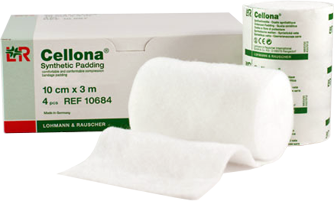How to Manage
Lymphedema
in Your Legs and Feet
Lymphedema occurs when your lymph nodes are damaged,
typically after cancer treatments. This can cause swelling
in your legs and feet. Because the build-up is caused
by lymph fluid and not water, diuretics won't help
reduce swelling. However, adding compression can help.
Reduce your lymphedema swelling
by using multi-layer compression bandaging!
Layer One:
Skin Protection
It's important to protect your skin when applying compression. A tg grip II Compression Stockinette is a good base layer for your leg or foot. The tubular stocking comes in different sizes to fit your thigh and calf. Be sure to wrap your fingers, too, using Mollelast dressing.


Layer Two:
Padding
The second step in applying multi-layer compression bandages is to wrap the area with padding. This helps prevent pressure sores from forming on your legs or feet. Cellona Synthetic Padding is breathable and simple to wrap in circular layers.


Layer Three:
Short Stretch Bandaging
The last step is to apply a short-stretch bandage, like Rosidal K Short Stretch Bandage, in several layers to create the desired amount of pressure and compression. Then you've finished the process that helps reduce your lymphedema swelling.


ReadyWrap
A Convenient Alternative
ReadyWrap garments are an alternative to multi-step bandaging. Available for the thigh, knee, calf, foot, and toe, these lower extremity pieces include a liner and multiple straps. This allows the wrap to be put on much more quickly and easily than the traditional multi-step system. The adjustable compression makes ReadyWrap garments convenient for managing swelling caused by lymphedema.










 France
France Australia
Australia

